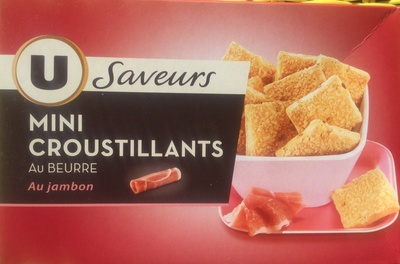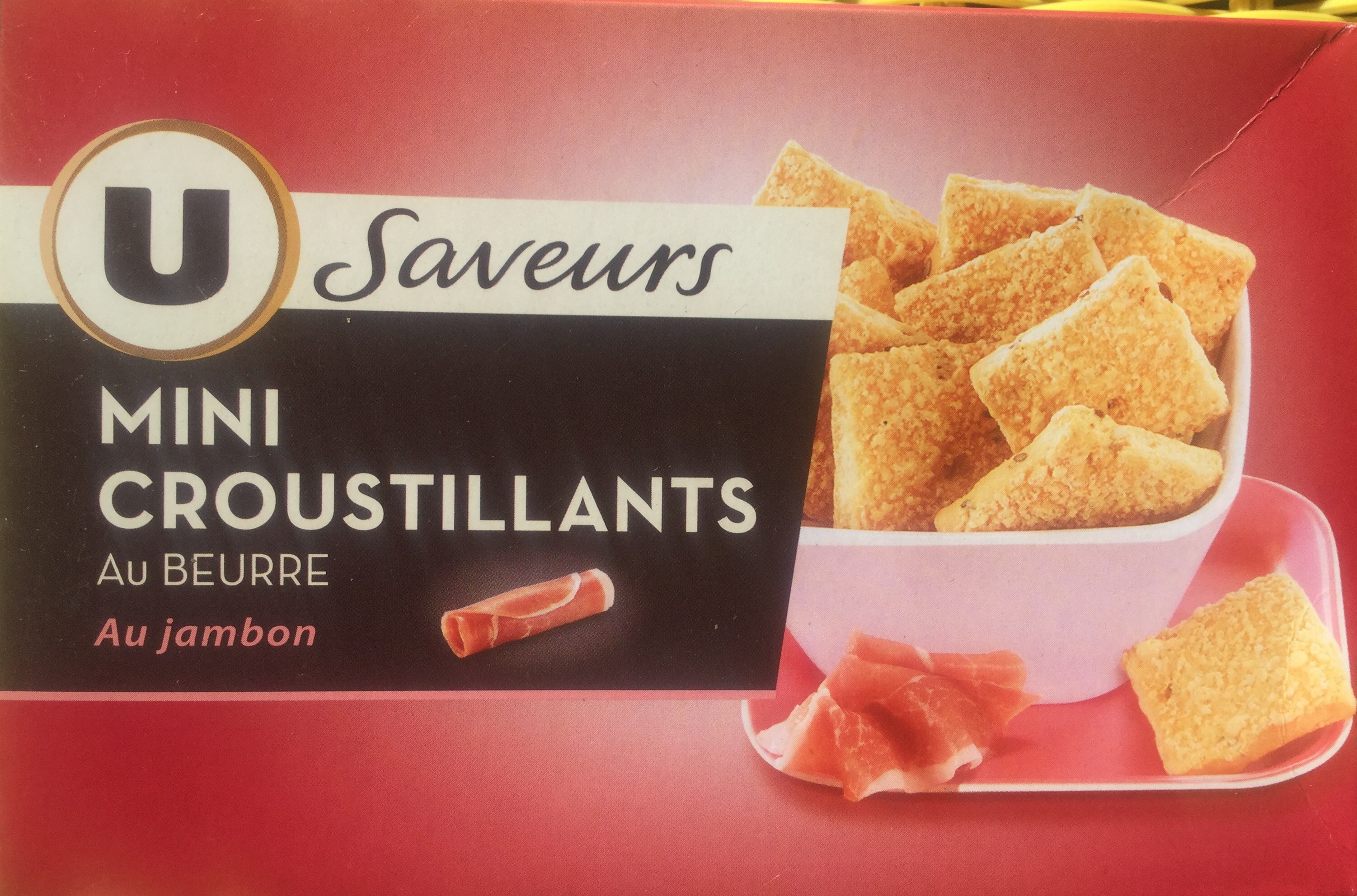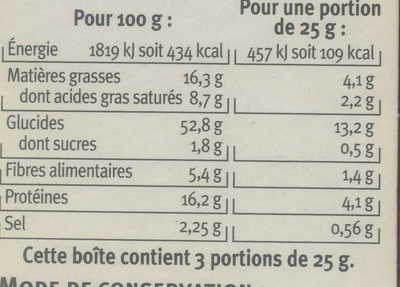Help us make food transparency the norm!
As a non-profit organization, we depend on your donations to continue informing consumers around the world about what they eat.
The food revolution starts with you!
Mini croustillants au beurre au jambon - U Saveurs - 75 g
Mini croustillants au beurre au jambon - U Saveurs - 75 g
This product page is not complete. You can help to complete it by editing it and adding more data from the photos we have, or by taking more photos using the app for Android or iPhone/iPad. Thank you!
×
Barcode: 3368954525572 (EAN / EAN-13)
Common name: Biscuits salés au gouda et jambon
Quantity: 75 g
Packaging: fr:Sachet à jeter, fr:Triman, fr:Étui carton à recycler
Categories: Snacks, Salty snacks, Appetizers, Crackers
Stores: Super U, Magasins U
Countries where sold: France
Matching with your preferences
Health
Ingredients
-
32 ingredients
French: farine de blé, fromage gouda 18% (dont colorant (rocou), conservateur (nitrate de sodium), beurre concentré 8%, mélange de graines et céréales (graines de lin, graines de sésame, graines de tornesol, flocons d'avoine), arôme de fumée, fibres de blé, poudres à lever (diphosphates et carbonates de sodium), tréhalose, sel, extrait de levure, poudre de jambon 0.6% (viande de porc séchée, dextrose, sel, sucre, épices, antioxydant (ascorbate de sodium, conservateur (nitrite de sodium), poivre noirAllergens: Gluten, Milk, Sesame seeds, fr:avoine
Food processing
-
Ultra processed foods
Elements that indicate the product is in the 4 - Ultra processed food and drink products group:
- Additive: E160b - Annatto
- Additive: E450 - Diphosphates
- Ingredient: Colour
- Ingredient: Dextrose
- Ingredient: Flavouring
- Ingredient: Glucose
Food products are classified into 4 groups according to their degree of processing:
- Unprocessed or minimally processed foods
- Processed culinary ingredients
- Processed foods
- Ultra processed foods
The determination of the group is based on the category of the product and on the ingredients it contains.
Additives
-
E250 - Sodium nitrite
Sodium nitrite: Sodium nitrite is the inorganic compound with the chemical formula NaNO2. It is a white to slightly yellowish crystalline powder that is very soluble in water and is hygroscopic. It is a useful precursor to a variety of organic compounds, such as pharmaceuticals, dyes, and pesticides, but it is probably best known as a food additive to prevent botulism. It is on the World Health Organization's List of Essential Medicines, the most important medications needed in a basic health system.Nitrate or nitrite -ingested- under conditions that result in endogenous nitrosation has been classified as "probably carcinogenic to humans" by International Agency for Research on Cancer -IARC-.Source: Wikipedia
-
E251 - Sodium nitrate
Sodium nitrate: Sodium nitrate is the chemical compound with the formula NaNO3. This alkali metal nitrate salt is also known as Chile saltpeter -because large deposits of this salt can be found in Chile- to distinguish it from ordinary saltpeter, potassium nitrate. The mineral form is also known as nitratine, nitratite or soda niter. Sodium nitrate is a white solid very soluble in water. It is a readily available source of the nitrate anion -NO3−-, which is useful in several reactions carried out on industrial scales for the production of fertilizers, pyrotechnics and smoke bombs, glass and pottery enamels, food preservatives -esp. meats-, and solid rocket propellant. It has been mined extensively for these purposes.Source: Wikipedia
-
E301 - Sodium ascorbate
Sodium ascorbate: Sodium ascorbate is one of a number of mineral salts of ascorbic acid -vitamin C-. The molecular formula of this chemical compound is C6H7NaO6. As the sodium salt of ascorbic acid, it is known as a mineral ascorbate. It has not been demonstrated to be more bioavailable than any other form of vitamin C supplement.Sodium ascorbate normally provides 131 mg of sodium per 1‚000 mg of ascorbic acid -1‚000 mg of sodium ascorbate contains 889 mg of ascorbic acid and 111 mg of sodium-. As a food additive, it has the E number E301 and is used as an antioxidant and an acidity regulator. It is approved for use as a food additive in the EU, USA, and Australia and New Zealand.In in vitro studies, sodium ascorbate has been found to produce cytotoxic effects in various malignant cell lines, which include melanoma cells that are particularly susceptible.Source: Wikipedia
-
E450 - Diphosphates
Diphosphates (E450) are food additives often utilized to modify the texture of products, acting as leavening agents in baking and preventing the coagulation of canned food.
These salts can stabilize whipped cream and are also found in powdered products to maintain their flow properties. They are commonly present in baked goods, processed meats, and soft drinks.
Derived from phosphoric acid, they're part of our daily phosphate intake, which often surpasses recommended levels due to the prevalence of phosphates in processed foods and drinks.
Excessive phosphate consumption is linked to health issues, such as impaired kidney function and weakened bone health. Though diphosphates are generally regarded as safe when consumed within established acceptable daily intakes, it's imperative to monitor overall phosphate consumption to maintain optimal health.
-
E500 - Sodium carbonates
Sodium carbonates (E500) are compounds commonly used in food preparation as leavening agents, helping baked goods rise by releasing carbon dioxide when they interact with acids.
Often found in baking soda, they regulate the pH of food, preventing it from becoming too acidic or too alkaline. In the culinary world, sodium carbonates can also enhance the texture and structure of foods, such as noodles, by modifying the gluten network.
Generally recognized as safe, sodium carbonates are non-toxic when consumed in typical amounts found in food.
Ingredients analysis
-
May contain palm oil
Ingredients that may contain palm oil: Butterfat
-
Non-vegan
Non-vegan ingredients: Butterfat, Ham, Pork meatSome ingredients could not be recognized.
We need your help!
You can help us recognize more ingredients and better analyze the list of ingredients for this product and others:
- Edit this product page to correct spelling mistakes in the ingredients list, and/or to remove ingredients in other languages and sentences that are not related to the ingredients.
- Add new entries, synonyms or translations to our multilingual lists of ingredients, ingredient processing methods, and labels.
If you would like to help, join the #ingredients channel on our Slack discussion space and/or learn about ingredients analysis on our wiki. Thank you!
-
Non-vegetarian
Non-vegetarian ingredients: Ham, Pork meatSome ingredients could not be recognized.
We need your help!
You can help us recognize more ingredients and better analyze the list of ingredients for this product and others:
- Edit this product page to correct spelling mistakes in the ingredients list, and/or to remove ingredients in other languages and sentences that are not related to the ingredients.
- Add new entries, synonyms or translations to our multilingual lists of ingredients, ingredient processing methods, and labels.
If you would like to help, join the #ingredients channel on our Slack discussion space and/or learn about ingredients analysis on our wiki. Thank you!
-
Details of the analysis of the ingredients
We need your help!
Some ingredients could not be recognized.
We need your help!
You can help us recognize more ingredients and better analyze the list of ingredients for this product and others:
- Edit this product page to correct spelling mistakes in the ingredients list, and/or to remove ingredients in other languages and sentences that are not related to the ingredients.
- Add new entries, synonyms or translations to our multilingual lists of ingredients, ingredient processing methods, and labels.
If you would like to help, join the #ingredients channel on our Slack discussion space and/or learn about ingredients analysis on our wiki. Thank you!
fr: farine de _blé_, _fromage_ gouda 18%, dont colorant (rocou), conservateur (nitrate de sodium), _beurre_ concentré 8%, mélange de graines, céréales (graines de lin, _graines de sésame_, graines de tornesol, flocons d'_avoine_), arôme de fumée, fibres de _blé_, poudres à lever (diphosphates de sodium, carbonates de sodium), tréhalose, sel, extrait de levure, jambon 0.6%, viande de porc, dextrose, sel, sucre, épices, antioxydant, ascorbate de sodium, conservateur (nitrite de sodium), poivre noir- farine de _blé_ -> en:wheat-flour - vegan: yes - vegetarian: yes - ciqual_proxy_food_code: 9410 - percent_min: 18 - percent_max: 52.6
- _fromage_ gouda -> fr:fromage-gouda - percent_min: 18 - percent: 18 - percent_max: 18
- dont colorant -> en:colour - percent_min: 8 - percent_max: 18
- rocou -> en:e160b - vegan: yes - vegetarian: yes - percent_min: 8 - percent_max: 18
- conservateur -> en:preservative - percent_min: 8 - percent_max: 18
- nitrate de sodium -> en:e251 - vegan: yes - vegetarian: yes - percent_min: 8 - percent_max: 18
- _beurre_ concentré -> en:butterfat - vegan: no - vegetarian: yes - from_palm_oil: maybe - ciqual_food_code: 16401 - percent_min: 8 - percent: 8 - percent_max: 8
- mélange de graines -> en:seed - vegan: yes - vegetarian: yes - percent_min: 0.6 - percent_max: 8
- céréales -> en:cereal - vegan: yes - vegetarian: yes - percent_min: 0.6 - percent_max: 8
- graines de lin -> en:flax-seed - vegan: yes - vegetarian: yes - ciqual_food_code: 15034 - percent_min: 0.15 - percent_max: 8
- _graines de sésame_ -> en:sesame-seeds - vegan: yes - vegetarian: yes - ciqual_food_code: 15010 - percent_min: 0 - percent_max: 4
- graines de tornesol -> fr:graines-de-tornesol - percent_min: 0 - percent_max: 2.66666666666667
- flocons d'_avoine_ -> en:oat-flakes - vegan: yes - vegetarian: yes - ciqual_food_code: 9311 - percent_min: 0 - percent_max: 2
- arôme de fumée -> en:smoke-flavouring - vegan: maybe - vegetarian: maybe - percent_min: 0.6 - percent_max: 5
- fibres de _blé_ -> en:wheat-fiber - vegan: yes - vegetarian: yes - percent_min: 0.6 - percent_max: 5
- poudres à lever -> en:raising-agent - percent_min: 0.6 - percent_max: 5
- diphosphates de sodium -> en:e450i - vegan: yes - vegetarian: yes - percent_min: 0.3 - percent_max: 5
- carbonates de sodium -> en:e500 - vegan: yes - vegetarian: yes - percent_min: 0 - percent_max: 2.5
- tréhalose -> en:trehalose - vegan: yes - vegetarian: yes - ciqual_proxy_food_code: 31016 - percent_min: 0.6 - percent_max: 1.8
- sel -> en:salt - vegan: yes - vegetarian: yes - ciqual_food_code: 11058 - percent_min: 0.6 - percent_max: 1.8
- extrait de levure -> en:yeast-extract - vegan: yes - vegetarian: yes - percent_min: 0.6 - percent_max: 1.8
- jambon -> en:ham - vegan: no - vegetarian: no - ciqual_proxy_food_code: 28205 - percent_min: 0.6 - percent: 0.6 - percent_max: 0.6
- viande de porc -> en:pork-meat - vegan: no - vegetarian: no - ciqual_proxy_food_code: 28205 - percent_min: 0 - percent_max: 0.6
- dextrose -> en:dextrose - vegan: yes - vegetarian: yes - ciqual_proxy_food_code: 31016 - percent_min: 0 - percent_max: 0.6
- sel -> en:salt - vegan: yes - vegetarian: yes - ciqual_food_code: 11058 - percent_min: 0 - percent_max: 0.6
- sucre -> en:sugar - vegan: yes - vegetarian: yes - ciqual_proxy_food_code: 31016 - percent_min: 0 - percent_max: 0.6
- épices -> en:spice - vegan: yes - vegetarian: yes - percent_min: 0 - percent_max: 0.6
- antioxydant -> en:antioxidant - percent_min: 0 - percent_max: 0.6
- ascorbate de sodium -> en:e301 - vegan: yes - vegetarian: yes - percent_min: 0 - percent_max: 0.6
- conservateur -> en:preservative - percent_min: 0 - percent_max: 0.6
- nitrite de sodium -> en:e250 - vegan: yes - vegetarian: yes - percent_min: 0 - percent_max: 0.6
- poivre noir -> en:black-pepper - vegan: yes - vegetarian: yes - ciqual_food_code: 11015 - percent_min: 0 - percent_max: 0.6
Nutrition
-
Poor nutritional quality
⚠ ️Warning: the amount of fruits, vegetables and nuts is not specified on the label, it was estimated from the list of ingredients: 0This product is not considered a beverage for the calculation of the Nutri-Score.
Positive points: 5
- Proteins: 5 / 5 (value: 16.2, rounded value: 16.2)
- Fiber: 5 / 5 (value: 5.4, rounded value: 5.4)
- Fruits, vegetables, nuts, and colza/walnut/olive oils: 0 / 5 (value: 0, rounded value: 0)
Negative points: 22
- Energy: 5 / 10 (value: 1819, rounded value: 1819)
- Sugars: 0 / 10 (value: 1.8, rounded value: 1.8)
- Saturated fat: 8 / 10 (value: 8.7, rounded value: 8.7)
- Sodium: 9 / 10 (value: 900, rounded value: 900)
The points for proteins are not counted because the negative points are greater or equal to 11.
Nutritional score: (22 - 5)
Nutri-Score:
-
Nutrient levels
-
Fat in moderate quantity (16.3%)
What you need to know- A high consumption of fat, especially saturated fats, can raise cholesterol, which increases the risk of heart diseases.
Recommendation: Limit the consumption of fat and saturated fat- Choose products with lower fat and saturated fat content.
-
Saturated fat in high quantity (8.7%)
What you need to know- A high consumption of fat, especially saturated fats, can raise cholesterol, which increases the risk of heart diseases.
Recommendation: Limit the consumption of fat and saturated fat- Choose products with lower fat and saturated fat content.
-
Sugars in low quantity (1.8%)
What you need to know- A high consumption of sugar can cause weight gain and tooth decay. It also augments the risk of type 2 diabetes and cardio-vascular diseases.
Recommendation: Limit the consumption of sugar and sugary drinks- Sugary drinks (such as sodas, fruit beverages, and fruit juices and nectars) should be limited as much as possible (no more than 1 glass a day).
- Choose products with lower sugar content and reduce the consumption of products with added sugars.
-
Salt in high quantity (2.25%)
What you need to know- A high consumption of salt (or sodium) can cause raised blood pressure, which can increase the risk of heart disease and stroke.
- Many people who have high blood pressure do not know it, as there are often no symptoms.
- Most people consume too much salt (on average 9 to 12 grams per day), around twice the recommended maximum level of intake.
Recommendation: Limit the consumption of salt and salted food- Reduce the quantity of salt used when cooking, and don't salt again at the table.
- Limit the consumption of salty snacks and choose products with lower salt content.
-
-
Nutrition facts
Nutrition facts As sold
for 100 g / 100 mlAs sold
per serving (25 g)Compared to: Crackers Energy 1,819 kj
(435 kcal)455 kj
(109 kcal)-4% Fat 16.3 g 4.08 g -6% Saturated fat 8.7 g 2.17 g +116% Carbohydrates 52.8 g 13.2 g -15% Sugars 1.8 g 0.45 g -53% Fiber 5.4 g 1.35 g +34% Proteins 16.2 g 4.05 g +69% Salt 2.25 g 0.562 g +22% Fruits‚ vegetables‚ nuts and rapeseed‚ walnut and olive oils (estimate from ingredients list analysis) 0 % 0 %
Environment
-
Eco-Score B - Low environmental impact
⚠ ️Select a country in order to include the full impact of transportation.The Eco-Score is an experimental score that summarizes the environmental impacts of food products.→ The Eco-Score was initially developped for France and it is being extended to other European countries. The Eco-Score formula is subject to change as it is regularly improved to make it more precise and better suited to each country.Life cycle analysis
-
Average impact of products of the same category: A (Score: 87/100)
Category: Salty snacks, crackers, plain
Category: Salty snacks, crackers, plain
- PEF environmental score: 0.22 (the lower the score, the lower the impact)
- including impact on climate change: 1.59 kg CO2 eq/kg of product
Stage Impact Agriculture
59.7 %Processing
22.4 %Packaging
10.6 %Transportation
5.2 %Distribution
2.2 %Consumption
0.0 %
Bonuses and maluses
-
Missing origins of ingredients information
Malus: -5
⚠ ️ The origins of the ingredients of this product are not indicated.
If they are indicated on the packaging, you can modify the product sheet and add them.
If you are the manufacturer of this product, you can send us the information with our free platform for producers.
-
Packaging with a medium impact
Malus: -11
Shape Material Recycling Impact Sleeve Cardboard Recycle Low Bag Unknown Discard High ⚠ ️ The information about the packaging of this product is not sufficiently precise (exact shapes and materials of all components of the packaging).⚠ ️ For a more precise calculation of the Eco-Score, you can modify the product page and add them.
If you are the manufacturer of this product, you can send us the information with our free platform for producers.
Eco-Score for this product
-
Impact for this product: B (Score: 71/100)
Product: Mini croustillants au beurre au jambon - U Saveurs - 75 g
Life cycle analysis score: 87
Sum of bonuses and maluses: -16
Final score: 71/100
-
Carbon footprint
-
Equal to driving 0.8 km in a petrol car
159 g CO² per 100g of product
The carbon emission figure comes from ADEME's Agribalyse database, for the category: Salty snacks, crackers, plain (Source: ADEME Agribalyse Database)
Stage Impact Agriculture
53.6 %Processing
18.8 %Packaging
17.7 %Transportation
8.7 %Distribution
1.2 %Consumption
0.0 %
Packaging
-
Packaging with a medium impact
-
Packaging parts
Sleeve (Cardboard)
Bag
-
Packaging materials
Material % Packaging weight Packaging weight per 100 g of product Paper or cardboard
-
Transportation
-
Origins of ingredients
Missing origins of ingredients information
⚠ ️ The origins of the ingredients of this product are not indicated.
If they are indicated on the packaging, you can modify the product sheet and add them.
If you are the manufacturer of this product, you can send us the information with our free platform for producers.Add the origins of ingredients for this product Add the origins of ingredients for this product
Report a problem
-
Incomplete or incorrect information?
Category, labels, ingredients, allergens, nutritional information, photos etc.
If the information does not match the information on the packaging, please complete or correct it. Open Food Facts is a collaborative database, and every contribution is useful for all.











